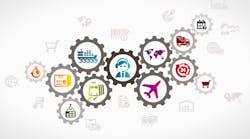The modern supply chain is an intricate spiderweb with threads spanning the globe, and COVID-19 arrived like a storm to punch significant holes throughout it. While globalization has created resiliency in the supply chain, mitigating many localized disasters, it has also set us up for systemic issues when the threat is large enough.
Like few things before it, COVID-19 had an immediate impact on the global supply chain and logistics market. In one fell swoop, the protections that made business more viable — especially outsourced manufacturing and lean inventory operations — have taken industries out at the knees.
The good news is that the recovery process is starting for many, and there are already lessons we can learn. The danger is that these must be learned quickly, and safeguards put into place.
Looking Beyond Direct Impacts
The coronavirus pandemic has caused supply chain professionals to face the reality of something we’ve been aware of but rarely felt the impact: All supply chains are linked and global. Black swan events are going to impact every business, for good or bad.
The scale of these changes is significant, and it’s up to professionals to start looking beyond companies and manufacturers directly impacted. For example, wholesalers of medicine are at significant risk. India is the world’s leading provider of generic prescription drugs. However, 70% of its raw materials come from China, and some 33% come directly from the epicenter of the coronavirus outbreak.
Mexico relies on those two countries for up to 95% of its active pharmaceutical ingredients. It faces an added risk because of the inter-reliance of its sources.
If you’re not looking at multiple stages up the chain, you could miss signs of how you’ll be impacted. China’s dominance in many areas is also making us collectively realize that not every supplier has access to alternative sources.
Reliance on a single region is an immediate risk, but also an area of opportunity for new companies in the future.
The hope is that this reality creates more awareness in the supply chain and logistics professions. We need to start looking at our own chains and those around us, sharing data, and discussing the state of things.
It’s impossible to operate alone, and those who can maintain their supply chains via greater protections are poised to find new avenues expanded by COVID-19.
Merging of B2B and B2C
Distribution has faced significant challenges, but companies that were able to adapt are at the forefront of where logistics is headed next. One key area seems to be the blending of B2B and B2C sales.
From breweries making hand sanitizer or brands shifting household cleaners to hospital clients down to gym equipment brands offering home delivery, the coronavirus has pushed companies outside of their comfort zone. Entire customer segments have been put on pause, while others have seen significant spikes due to hoarding early on in the crisis. Retailers who had existing problems or couldn’t adapt have shut down and may not return.
Changes to customer targets are happening and likely to continue through the rest of 2020 and beyond.
For 3PLs and other supply chain outsourcing operations, the coronavirus has created the need to be agile and flexible. By supporting both bulk freight and breaking down pallets to individual units for consumer-level purchases, these professionals can assist customers that quickly adapt to different selling situations.
These companies will need to manage and monitor staffing levels and introduce capabilities to reach multiple types of targets. Systems will need to get smarter, and margins controlled. There’s going to be greater scrutiny of outsourcing. However, it also comes with clear examples of how to demonstrate value. Amazon’s halting of some third-party seller inventory during the pandemic was just the most recent issue those sellers are having.
By adapting to both B2B and B2C markets and deliveries, brands and their supply chain operations may be able to move past the risks of some markets and their fulfillment requirements while also identifying new avenues for sales and growth.
The Second Wave Approaches
The most significant impact that we see in the logistics and supply chain space is what’s to come next. There’s a second wave of shutdowns, closures, stay-at-home orders, and more headed our way. We’re still a pre-vaccine supply chain. Beijing is already experiencing this, and safety measures are expected to hundreds of thousands if not millions of people in that city alone.
The Institute for Health Metrics and Evaluation has forecast that a second wave will take full force in the U.S. starting mid-September. Travel, work, and any gaps in testing can contribute to the growing threat.
When the second wave hits, we don’t know what will happen. What companies will maintain an open operating status? Will governments respond with continued economic relief for citizens? Will companies that struggled but survived the first round of closures be able to survive the second?
The impact on supply chains and logistics networks right now needs to be planning for that second wave. Professionals and companies need to start shoring up their inventory and discussing supply chain reach. Alternative sourcing, warehouse safety policies, and a shift away from some past agile practices might be needed. Companies can also start to protect ongoing priorities by taking a fresh look at old practices thought to not be reliable for sales — such as offering e-commerce backorders.
Lockdown harms are often propagated through supply chains, whether that’s direct harm or in those related supply chains. Your supply chain is global, and both ends are expanding. It’s time to do the work of preparation and planning. If you’re a 3PL or someone who handles logistics and supply chain issues for others, it’s time for you to start ensuring you can support the wild swings in inventory, targets, end-customers, and orders that came during the first wave.









